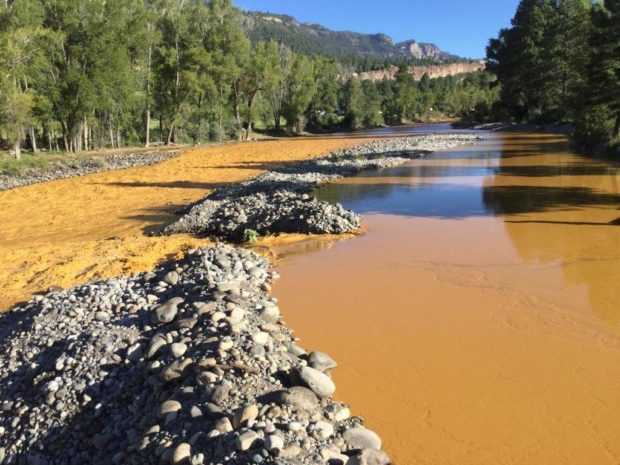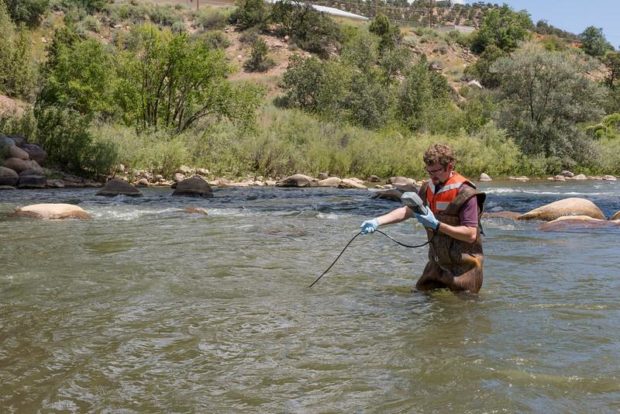We have much more to do and your continued support is needed now more than ever.
8 Hard Truths About Hardrock Mining
The Gold King Mine disaster in Colorado was an accident waiting to happen. It’s not a unique situation, in part because the laws regulating mining are inadequate on several fronts.
Rivers shouldn’t be the color of mustard. But that’s just what happened earlier this month after the EPA’s attempts at cleaning up a leaking, abandoned mine accidentally released 3 million gallons of contaminated water into the Animus River in Colorado. The images were shocking, but the big picture behind this disaster may be even more so.
What’s been missing from most of the media coverage is that decades of Congressional inaction set the stage for this crisis—and the fact that something similar could happen again elsewhere, unless Congress steps up.

1) Abandoned Mines are Nationwide
There are an estimated 23,000 abandoned mines in Colorado and as many as half a million across the nation. Mining has contaminated the headwaters of more than 40 percent of the watersheds in the West.
Remediation of the half-million abandoned mines nationwide could cost as much as $50 billion. The Gold King mine had been leaking for years and it’s not the only one: more than two hundred mines in Colorado leak heavy metals into rivers and streams, in amounts estimated to be equal to at least one Gold King disaster every two days.
2) Archaic Law Still in Effect
Many of the abandoned mines nationwide—including in the Silverton area where Gold King is located—were developed after the 1872 General Mining Law was passed. This law, originally aimed at encouraging the settlement of the West, still allows miners to extract gold, silver, and uranium from public lands without any royalties to taxpayers. And until fairly recently, the federal government was handing over valuable lands to mining companies for a mere $5 an acre. Over the decades, an area of public lands the size of Connecticut has been essentially given away. This outdated law remains the basic template for mining on nearly 500 million acres of public land.
3) No Clean-Up Funding
Congress has not required any sort of remediation funding or royalty payments for mines since the 1872 General Mining Law was passed. By contrast, the coal industry has been required to pay a fee per ton of produced coal into a federal/state cleanup fund for abandoned mines since 1977. But the hardrock mining industry has been fighting efforts to create a similar fund for decades.
4) No Good Samaritans
The hardrock industry has also fought off efforts to pass more narrowly-focused remedies, particularly “Good Samaritan” reclamation legislation. This type of law would allow private parties to clean up abandoned mines by lifting personal party long-term legal liability for water quality while working on the site. Right now, this potential for liability serves as an enormous disincentive for private parties to attempt tackling even smaller cleanup efforts. Important note: Private cleanup would not have been a viable or responsible tool for handling a situation of the magnitude at the Gold King mine.
5) Underfunded Superfund
The abandoned mining area around Gold King was targeted by the EPA for a potential Superfund designation in the early 1990s, but the EPA’s overtures were rebuffed by local authorities and mining companies for fear of damaging property values, tourism and the mining industry. However, had cleanup begun 25 years ago, it is quite possible the disaster on the Animas would not have happened today.
Superfund is the best tool we have for complicated cleanup situations like this one, but the program has been underfunded for decades. Today, the American people are paying to clean up the sites industry has abandoned—with the result that funding has declined. The EPA estimates that approximately 49 million people live within 3 miles of Superfund sites.
6) Clean Water Act Loopholes
Pollution problems are not limited to abandoned mines. Modern mines also cause pollution issues, and federal regulations are inadequate here too. In addition to the limitations of the 1872 Mining Law, there are two “mining loopholes” in the regulations implementing the Clean Water Act. These loopholes essentially allow mining companies to “treat” their waste by damming up the nearest river valley and using wetlands and streams impounded by the dam as a toxic waste dump.
Controversial projects such as the proposed Pebble mine in Alaska, Montanore mine in Montana, PolyMet mine in northern Minnesota, Mt. Emmons mine in Colorado, Haile mine in South Carolina all rely on these Clean Water Act loopholes.
7) Disproportionate Impacts on Tribes
Collectively, our nation’s laws serve to encourage mining near reservations, and have even allowed mining companies to lease minerals on tribal lands, sometimes without tribal consent. The result: American Indians and Alaska Natives have disproportionately suffered the impacts of mining while enjoying few of its benefits. In a continuation of this long trend, this spill flowed through Navajo Nation. Tribes face more threats as a new wave of exploration and mining projects sweeps through the country.
8) Fish Harmed by Mining
Before the Animas River spill, drainage from the Silverton mines had already wiped out all the fish in the stream closest to the Gold King mine. The Durango Herald reported last year that ongoing mine pollution had killed three out of four of the fish species in the Upper Animas and decreased the volume of insects and number of bug species, the food fish rely on. The long-term impacts of this event will need careful study.
Last year, scientists at Michigan State University reported that mining can damage fish habitats miles downstream, and even in streams not directly connected to the mines. For example, pollutants from a mine in a headwater stream in Kentucky were thought to disrupt the breeding grounds of bass in Tennessee rivers.

Two Immediate Steps Congress Can Take
The EPA has recently finalized a narrow piece of regulation dubbed the “Clean Water Rule” that would ensure that the types of headwater streams often affected by mining waste would qualify for Clean Water Act protections—a point left unclear by two controversial Supreme Court decisions. This rule could help prevent future disasters like the one on the Animas River and would at least allow for better enforcement if something terrible did happen.
We also need to address the bigger picture–and it looks like the disaster on the Animus will inspire bills on this topic in the next legislative session. Congress needs to reform the 1872 mining law so industry pays royalties on valuable metals and minerals extracted from land owned by the public. These royalties should feed into a national trust for cleaning up abandoned hardrock mines.
 Ask Congress not to block or delay the Clean Water Rule now!
Ask Congress not to block or delay the Clean Water Rule now!
Tell Congress to end 140 years of public subsidies for the hardrock mining industry and use the resulting royalties to clean up toxic mines!




















